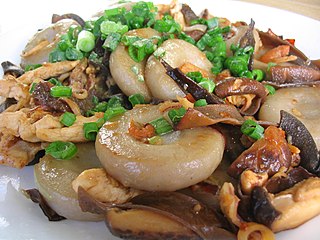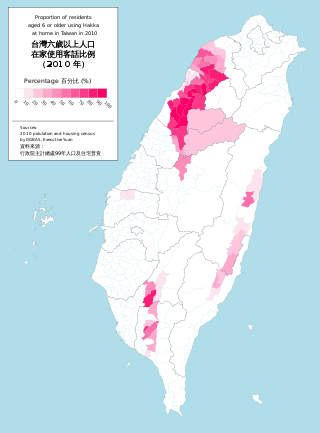
Hakka cuisine is the cooking style of the Hakka people, and it may also be found in parts of Taiwan and in countries with significant overseas Hakka communities. There are numerous restaurants in Mainland China, Taiwan, Hong Kong, Indonesia, Malaysia, Singapore, India, Thailand and the United States serving Hakka cuisine. Hakka cuisine was listed in 2014 on the first Hong Kong Inventory of Intangible Cultural Heritage.

Hakka forms a language group of varieties of Chinese, spoken natively by the Hakka people in parts of Southern China and some diaspora areas of Taiwan, Southeast Asia and in overseas Chinese communities around the world.

The Hakka, sometimes also referred to as Hakka Han, or Hakka Chinese, or Hakkas, are a Han Chinese subgroup whose ancestral homes are chiefly in the Hakka-speaking provincial areas of Guangdong, Fujian, Jiangxi, Guangxi, Sichuan, Hunan, Zhejiang, Hainan, and Guizhou in China, as well as in Taoyuan City, Hsinchu County, Miaoli County, Pingtung County, and Kaohsiung City in Taiwan. Unlike other Han Chinese subgroups, the Hakkas are not named after a geographical region, e.g. a province, county or city, in China. That is because their origins were of northern Chinese refugees fleeing social unrest, upheaval and invasions throughout the northern parts of China throughout history who then sought sanctuary in the south where the Cantonese speaking provinces such as Guangdong and Guangxi are. The Chinese characters for Hakka literally means "guest families". The word is Cantonese in origin and as the name implies, they are the guest of the Cantonese people. Over the centuries though, they have since more or less assimilated with the Cantonese speaking population. Modern day Hakka are generally identified by both full Hakka and by different degrees of Hakka ancestry and usually speak Hakka Chinese.
Taiwanese language is a name for Taiwanese Hokkien.

Hakka hill songs are rural songs sung in the Hakka language by the Hakka people. They are probably one of the better known elements that reflect Hakka culture, regarded by many as the 'pearl of Hakka Literature'.

Meizhou is a prefecture-level city in eastern Guangdong province, China. It has an area of 15,864.51 km2 (6,125.32 sq mi), and a population of 3,873,239 as of the 2020 census. It comprises Meijiang District, Meixian District, Xingning City and five counties. Its built-up or metro area made up of two urban districts was home to 992,351 inhabitants.

Tangra is a region in East Kolkata that traditionally housed many tanneries owned by people of Hakka Chinese origin.

Tuaran is the capital of the Tuaran District in the West Coast Division of Sabah, Malaysia. Its population was estimated to be around 128,200 in 2019 with half the population consists of ethnic Dusuns, most of the Lotud ethnic subgroup as well of Bajau descent. The remainder is mostly of the Malaysian Chinese community, particularly from the Hakka subgroup and Malay. The town is bordered on three sides by the Tuaran River. It is located 34 kilometres (21 mi) north of the state capital Kota Kinabalu, and is strategically situated along the main highway linking Kota Kinabalu with the north of Sabah.

Banmian or pan mee is a popular Chinese noodle dish, consisting of handmade noodles served in soup. Other types of handmade noodles include youmian, or mee hoon kueh.
Haifeng County is a county under the administration of Shanwei, in the southeast of Guangdong Province, China.
Pha̍k-fa-sṳ is an orthography similar to Pe̍h-ōe-jī and used to write Hakka, a variety of Chinese. Hakka is a whole branch of Chinese, and Hakka dialects are not necessarily mutually intelligible with each other, considering the large geographical region. This article discusses a specific variety of Hakka. The orthography was invented by the Presbyterian church in the 19th century. The Hakka New Testament published in 1924 is written in this system.

The languages of Taiwan consist of several varieties of languages under the families of Austronesian languages and Sino-Tibetan languages. The Formosan languages, a geographically designated branch of Austronesian languages, have been spoken by the Taiwanese indigenous peoples for thousands of years. Owing to the wide internal variety of the Formosan languages, research on historical linguistics recognizes Taiwan as the Urheimat (homeland) of the whole Austronesian languages family. In the last 400 years, several waves of Han emigrations brought several different Sinitic languages into Taiwan. These languages include Taiwanese Hokkien, Hakka, and Mandarin, which have become the major languages spoken in present-day Taiwan.

Hakka himeshimensis is a species of the spider family Salticidae. It is the only species in the genus Hakka. H. himeshimensis is native to East Asia, but it has been introduced to the United States. The species is most commonly found in rocky coastal habitats.

Xiong is the pinyin romanization of the Chinese surname 熊 (Xióng). It is 41st in the Hundred Family Surnames, contained in the verse 熊紀舒屈.

Fa gao, also called fat pan (發粄) by the Hakka, prosperity cake, fortune cake, Cantonese sponge cake, is a Chinese steamed, cupcake-like pastry. Because it is often characterized by a split top when cooked, it is often referred as Chinese smiling steamed cake or blooming flowers. It is commonly consumed on the Chinese new year. It is also eaten on other festivals, wedding, and funerals by the Hakka people.
The Meixian dialect, also known as Moiyan dialect, as well as Meizhou dialect (梅州話), or Jiaying dialect and Sixian dialect, is the prestige dialect of Hakka Chinese. It is named after Meixian District, Guangdong.
Hagfa Pinyim is a system of romanization used to transcribe Chinese characters as used in Hakka into Latin script. Hagfa Pinyim was developed by Lau Chun-fat for use in his Hakka Pinyin Dictionary that was published in 1997. The romanization system is named after the Pinyin system used for Mandarin Chinese and is designed to resemble Pinyin.

Taiwanese Hakka is a language group consisting of Hakka dialects spoken in Taiwan, and mainly used by people of Hakka ancestry. Taiwanese Hakka is divided into five main dialects: Sixian, Hailu, Dabu, Raoping, and Zhao'an. The most widely spoken of the five Hakka dialects in Taiwan are Sixian and Hailu. The former, possessing 6 tones, originates from Meizhou, Guangdong, and is mainly spoken in Miaoli, Pingtung and Kaohsiung, while the latter, possessing 7 tones, originates from Haifeng and Lufeng, Guangdong, and is concentrated around Hsinchu. Taiwanese Hakka is also officially listed as one of the national languages of Taiwan. In addition to the five main dialects, there are the northern Xihai dialect and the patchily-distributed Yongding, Fengshun, Wuping, Wuhua, and Jiexi dialects.

The Sixian dialect, also known as the Sixian accent, is a dialect of Hakka used by Taiwanese Hakkas, and it is the most spoken dialect of Taiwanese Hakka, being used in Hakka broadcasting in many public occasions. The Sixian dialect is generally spoken in northern and southern Taiwan, with main representative regions being Taoyuan and Miaoli in the north, as well as the Liudui Region in Kaohsiung and Pingtung in the south.
Hakka Americans, also called American Hakka, are Han people in the United States of Hakka origin, mostly from present-day Guangdong, Fujian, and Taiwan. Many Hakka Americans have connections to Hakka diaspora in Jamaica, the Caribbean, South East Asia, Latin America, and South America. The Han characters for Hakka (客家) literally mean "guest families". Unlike other Han ethnic groups, the Hakkas are not named after a geographical region, e.g. a province, county or city. The Hakkas usually identify with people who speak the Hakka language or share at least some Hakka ancestry. The earliest Hakka immigrants to what is now the United States mostly went to Hawaii, starting when the Kingdom of Hawaii was an independent sovereign state. After the lifting of the Chinese Exclusion Act by the passage of the Magnuson Act in 1943, the Hakka began to come to the US from Taiwan and to a lesser extent Hong Kong, Southeast Asia, Jamaica and the Caribbean.













